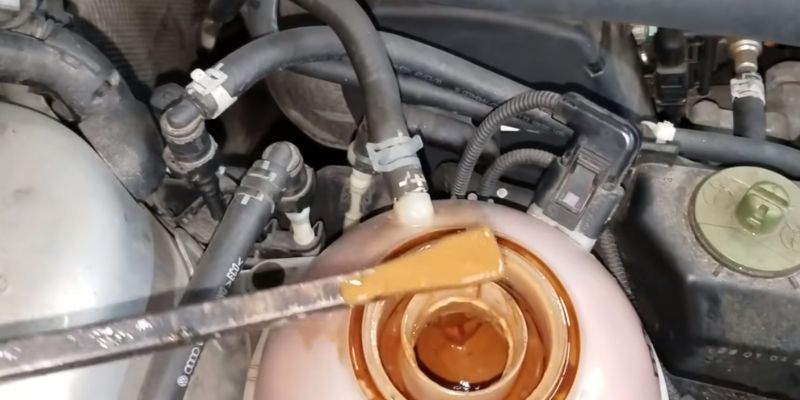If you notice your engine coolant has taken on a brown hue, you may be wondering what could be causing the discoloration. Coolant is normally green or blue straight from the bottle, so a color change is often a warning sign that something may be affecting your vehicle’s cooling system.
Brown coolant is usually an indication that contamination has occurred within the cooling system. The oil contamination with coolant results in the form of brown sludge in the coolant reservoir. Other reasons like a rusty radiator and mixing of incompatible coolants also result in discolored coolant colors.
In this article, we will solve your confusion about why is my coolant brown and what causes the brown coolant. Additionally, you will explore the effects of brown coolant and the risks of using the brown sludge coolant for a long time.
Let’s find out what is brown coolant.
What is Brown Coolant?
Brown coolant is the coolant that is contaminated with oil leaking out of the engine parts. This can happen for multiple reasons like a blown head gasket or damaged cylinder head.
Coolant turns brown when oxidation occurs during the exposure to heat cycles. The rusty particles in the radiator and sewage can also be the culprit behind the coolant discoloration.
The darker the brown, the heavier the contamination levels likely are within the cooling loop.
5 Causes of Brown Coolant
1. Rust and Corrosion
One common culprit behind brown coolant is the presence of rust and corrosion within the cooling system. Over time, metal components can break down, leading to the discoloration of the coolant. This is often a sign of neglected maintenance.
2. Oil Contamination
Another reason for brown coolant could be the infiltration of oil into the cooling system. This can occur due to a faulty gasket or a damaged cylinder head, resulting in the mixing of oil and coolant. Identifying this issue promptly is crucial to prevent extensive damage to the engine.
3. Mixing Different Coolant Brands
Sometimes, the use of incompatible coolant brands can lead to a brownish hue. It’s essential to use the recommended coolant for your specific vehicle to avoid chemical reactions that could alter the color and compromise the coolant’s effectiveness.
4. Old or Contaminated Coolant
Old or contaminated coolant is a common cause of brown discoloration in a vehicle’s cooling system. Over time, coolant loses its effectiveness due to exposure to high temperatures and the accumulation of impurities. This aging coolant may develop a brownish tint, signaling reduced performance.
5. Air Bubbles in the Cooling System
Air in the cooling system can contribute to brown coolant. Oxygen exposure can lead to oxidation, causing the coolant to change color. Bleeding air bubbles from the system through proper maintenance procedures helps prevent discoloration, ensuring the coolant retains its intended properties for effective engine cooling and corrosion prevention.
Effects of Brown Coolant
Here are the potential effects of brown coolant:
Reduced Heat Transfer Ability
Coolant loses its ability to efficiently absorb and dissipate heat from the engine as it becomes contaminated and changes color. Overheating risk increases.
Increased Corrosion
Protective additives are compromised, allowing coolant to corrode and scale up internal cooling system components like the radiator and block over time.
Reduced Freeze Protection
Discolored coolant is no longer as effective at preventing freezing due to additive depletion. Engine damage can occur during cold starts.
Low Coolant Life Expectancy
Contaminated brown coolant has to be fully drained and replaced more quickly, as it no longer offers the same longevity as fresh coolant.
Cooling System Damage
Long-term use of non-protective browned coolant exposes the rubber hoses, water pump seals, and gaskets to additional heat stress and breakdown.
Overheating Problems
As contaminants build up in the brown coolant, heat transfer worsens and raises the risk of temperature spikes that can lead to cracks or warping.
Loss of Lubricity
Lubricants in clear coolant are depleted, increasing friction and wear between close-tolerance cooling system parts.
Overall System Failure Risk
Continued use of brown coolant increases the chances of a complete cooling system failure due to reduced effectiveness and component degradation over time.
Differences in Brown Coolant Hues
Dark brown indicating extensive contamination
A very dark brown color, almost black, indicates severe contamination has occurred inside the cooling system. This could be from extensive unrepaired leaks that allowed dirt, oil, or gasses to thoroughly mix with the coolant.
Over many years, these contaminants have degraded the protection levels severely, necessitating an immediate flush and refill.
Light brown suggesting early signs of oxidation
A lighter golden brown shade may only suggest initial signs of oxidation from air entering the system. The coolant’s additives have started to break down but cooling protection is still mostly intact.
Catching it at this stage allows for repairing any air entry points and performing a quick refresh flush to restore like-new protection before further breakdown occurs.
Blackish brown involving combustion gasses
A blackish, charcoal brown color likely means combustion gasses from the cylinders have leaked into coolant channels, such as through a degraded head gasket.
These corrosive gasses have chemically reacted with the fluid, draining out all lubricity and heat-transfer properties. Head gasket replacement is urgently needed in this case to avoid permanent engine damage.
Diagnosing the Cause of Brown Coolant
These are three methods to diagnose the cause of brown coolant. You need to diagnose the reason for coolant contamination and fix it accordingly.
Coolant testing to detect combustion gasses
A coolant gas test uses a chemical agent that changes color in the presence of combustion gasses like oxygen, carbon dioxide, or hydrogen.
If gasses are present, it will point to a damaged head gasket. This precise lab test helps pinpoint if overheating or gasses contaminated the coolant.
Pressure testing of the cooling system
Pressurizing the cooled-off system while inspecting for pressure loss over time can expose invisible external leaks.
An internal pressure gauge can also signal if a leaking head gasket is allowing compression gasses into coolant jackets. This testing targets leaks as a contamination origin.
Visual inspection of components
Thoroughly inspecting the conditions of the water pump, hoses, radiator, and thermostat housing exterior lets mechanics examine components for external signs of coolant seepage or cracking that introduced outside impurities.
Catching the flawed part reveals how contamination infiltrated.
How to fix brown coolant?
Here are the most effective methods to fix brown coolant issue:
Coolant Flush
Completely drain and flush the old brown coolant from the entire cooling system, including the radiator, engine blocks, and heater core. This removes contamination.
Inspect Components
Inspect all cooling system components like hoses, water pumps, and thermostats for leaks or damage. Repair or replace as needed to prevent future issues.
Refill with Fresh Coolant
Refill the cooling system with new premixed coolant following the manufacturer’s dilution guidelines. Use only distilled/deionized water to mix.
Bleed Air from the System
With the radiator cap off, run the engine to circulate coolant and bleed any trapped air at bleed points and highest coolant outlets.
Pressure Test
Pressure tests the system when cold to check for leaks over hours. Repair any leaks found to ensure no air/contamination re-entry.
Follow Maintenance
Check coolant levels and condition regularly as part of routine maintenance. Flush again if discoloration returns to fully resolve the root problem.
Cost to Fix Brown Coolant
Here are some potential costs associated with fixing a brown coolant issue:
Coolant flush – $100-200
This involves draining the old coolant and flushing the cooling system to remove residues. May require multiple cycles.
Coolant replacement – $30-60
New premixed coolant to refill the system after flushing. Use genuine OEM coolant.
Cooling system inspection – $50-100
Mechanic labor to inspect all hoses, water pumps, and radiators for leaks or damage.
Component replacement(s) – Variable costs
Examples: water pump -$150-350, radiator – $200-500, hoses – $50-150 each, thermostat – $30-60.
Head gasket replacement – $800-1200
Needed if leakage or combustion gasses contaminated the coolant. Major repair.
Head/block replacement – $1000+
Required if overheating or warping damaged the head or block irreparably.
Labor costs – $80-150/hr
Labor will be required for flush, inspection, and repairs/replacements. 1-4 hours typically.
Adding it all up, addressing a minor brown coolant issue could cost $250-500 typically. A worse case overheating problem might reach $2000-3000 with major component replacement or rebuild essential.
Why Does Coolant Turn Brown After a Flush?
Here are some potential reasons why coolant could turn brown again after flushing, along with fixes:
Unresolved Contamination Source – A lingering coolant or oil leak was not found and repaired, allowing contaminants to re-enter the system. A thorough inspection is needed to fix ongoing entry points.
Incomplete Flush – Not enough radiator fill-drain cycles were done to fully remove sludge buildup inside the engine. Additional flushing is required to clean all residues.
Air in Coolant – Trapped air was not properly bled out, leading to oxidation and re-discoloration over time. Careful bleeding from all bleed points fixes this.
Hard Water Minerals – If topped off with tap water, minerals accumulate in the coolant that may result in the form of coolant discoloration. Only use distilled water to prevent this.
Cooling System Galvanic Corrosion – Dissimilar metals corrode, shedding particles that discolor coolant. Use correct replacement components to fix long-term.
Head Gasket Failure – Internal combustion gasses from a failing head gasket continually contaminate coolant. Head gasket replacement is necessary.
Can Brown Coolant Cause Overheating?
Yes, brown coolant can cause engine overheating as brown coolant loses its ability to effectively cool an engine due to degraded additives and the buildup of contaminants.
This compromised brown fluid struggles to transfer heat away from hot components.
With reduced heat transfer capabilities and potential flow restrictions caused by internal residues and corrosion, brown coolant cannot properly regulate temperatures under load.
The engine then risks overheating issues if the brown coolant is not replaced with a new coolant formulated to maximize cooling protection.
Risks of Driving with Brown Coolant
Here are some of the key risks of continuing to drive with brown coolant:
Engine Overheating
Brown coolant cannot adequately transfer heat from the engine. Prolonged or repeated overheating can cause head gasket failure, cracked heads, or blocks. Overheating also increases wear on internal components.
Cooling System Failure
The buildup of residue from brown coolant reduces flow and insulation increases with contaminants. Total melting of the radiator hoses through inefficient heat transfer can occur from loss of proper cooling, causing a full breakdown.
Permanent Engine Damage
Overheating for too long allows combustion gasses or coolants to infiltrate oil and contaminate it. This leads to accelerated engine wear and damage to pistons, cylinders, and bearings from inadequate lubrication at high temperatures.
Environmental Hazard
Breakdowns while driving risk spilling antifreeze onto roadways. Antifreeze is toxic and must be handled as hazardous waste if discharged into the environment untreated during a cooling system failure.
Expensive Repairs
Continued use of brown coolant greatly increases the odds of a prematurely failed cooling system and engine repair bills. Catching issues early by replacing them saves repair costs compared to neglecting the problem.
Final Verdict
Coolant turns brown over time due to contamination from internal engine wear, leaks, or inadequate maintenance. This compromises the coolant’s ability to regulate the engine’s temperature effectively.
With reduced heat transfer capabilities, brown coolant cannot properly cool the engine under heavy loads or high external temperatures. Continued overheating may even warp the engine block, necessitating an extremely expensive rebuild.
That’s why it is crucial to address brown coolant problems instead of ignoring them. Failing to fix the root cause can potentially result in catastrophic cooling system failure and costly repairs that could have otherwise been prevented.

Hi, Michael Williams here. I have always loved everything with an engine. After earning my degree in automotive engineering, I spent 5 years testing vehicles for a major manufacturer in Illinois. Now I am using my technical skills to review the latest models online and help others troubleshoot their engine problems with effective solutions.
